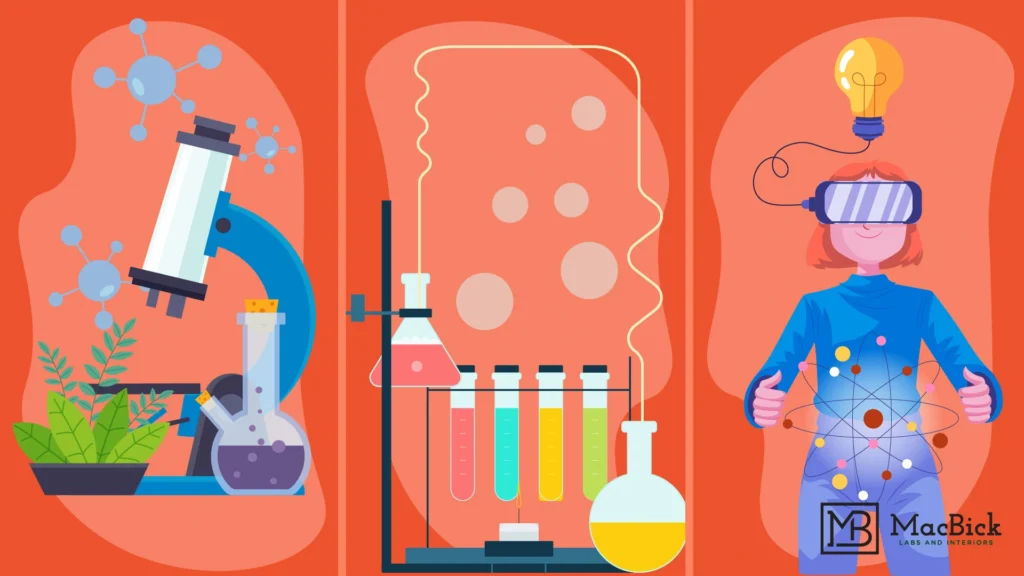Investing in lab designs and infrastructure is one of the wisest decisions. A better design and infrastructure have numerous benefits, including improved overall productivity. The high quality of instruments and designs also increases the ability to conduct experiments better, allowing for more experiments.
However, these designs vary according to the lab’s specific discipline. The most common labs are physics labs, chemistry labs, biology labs, etc. However, one often gets confused between the designs and essentials needed for these labs.
Let’s see how the physics labs, chemistry labs, and biology labs are different from each other:
Chemistry Labs vs. Biology Labs vs. Physics Labs
In context of their essential needs and required designs, all the 3 labs differ from each other. Let us discuss each of them one by one:
Chemistry Lab
The scientific study of matter and the chemical reactions between various substances are the base of chemistry. In chemistry, the study of organic or inorganic molecules involves various experiments that require unique designs and needs.
Biology Lab
A lab dealing with living organisms or microorganisms and their processes is known as a biology lab. Not only this, but biology differs from others because it also deals with medicine, genes, and the DNA of living organisms. The most common apparatus required are microscopes, incubators, etc.
Physics Lab
Labs performing experiments to deal with the nature and properties of matter and energy are known as the physics lab. Instruments commonly used in physics labs include voltmeters, ammeters, meter scales, gauges, etc.
Now, let us look at the uniqueness required in lab designs for all the 3 labs:
Chemistry Lab Considerations
A lab dealing with organic and inorganic molecules needs the following kind of lab design for its smooth functionality. Let’s look at them:
Emergency Exits
Chemistry labs are more prone to hazardous incidents, such as the release of poisonous gases or the fall of acids. Therefore, emergency exits must be made in chemistry labs. Also, the lab is prone to fire attacks; hence, the fire extinguishers must be easily accessible.
Fume Hoods
Chemistry experiments often involve the release of gases and vapors that might be hazardous. Therefore, proper ventilation chambers are needed to prevent accidents.
Modular cabinets
To avoid chaos while performing experiments, it’s better to store the chemicals and apparatuses in modular cabinets and label them. Modular cabinets offer well-organized storage for apparatuses like spectrometers, chromatography equipment, etc.
Rubber storage drawers
Installing the drawers with layers of rubber or polystyrene can prevent the breakage of brittle materials like test tubes, China dishes, etc.
Color recommendation
It’s better to keep the walls a little white or gray. These colors do not interfere with the identification of chemical spills or stains. Also, they create a clean and professional look that helps highlight any potential hazards.
Let us now dive into the design of a biology lab:
Biology Lab Considerations
A lab dealing with the processes related to living organisms and microorganisms has unique needs for its proper functioning. Let us look at the lab designs appropriate for it:
Hygiene
Researchers often work with bacteria, viruses, and various microorganisms, which makes them more prone to infections or diseases. Therefore, it is necessary to keep the equipment and the entire lab germ-free. Sanitizer sprayers can also be installed for this purpose.
Spaces
Ensure the appropriate storage spaces for the installation of instruments like microscopes, centrifuges, incubators, etc. These spaces must be clean, dry, and ventilated. Modular casework or pedestal-mounted workbenches can be the appropriate furniture for biology labs.
Ensure the availability of a wide sink or more sinks, as they are frequently used in the biology labs for disposal purposes.
Cryogenic Storage
Cryogenic storage methods must be installed to store cryogenic materials (solid, liquid, or gas) at -130°F or even less. This helps the materials from further decaying by stopping their metabolic activity via extreme coldness.
Color Recommendation
Light green is one of the best options for a biology lab. It has a calming effect and helps to maintain focus in detailed work like dissection and microscopic observations.
Physics Lab Considerations:
A part of science dealing with the characteristics and nature of matter and energy has distinctive needs. Let us look at them:
Furniture
Appropriate storage of digital instruments like an ammeter, screw gauges, resistors, meter scales, ball and reign apparatus, etc. These digital instruments have different sizes and shapes and thus require suitable storage solutions.
Modular casework, vertical carousels, skirting-mounted workbenches, and other options are good for the physics lab.
Electricity
Out of the 3 labs, the physics lab requires frequent electricity usage for the instruments’ functioning. Therefore, ensure the installation of inverters or generators to ensure the availability of electricity 24/7.
Spacious
It is better to provide the researchers with a spacious physics lab. Few experiments often require the connection of various equipment, wires, etc. which requires a lot of space to avoid chaos.
Color Recommendation
White or light blue are the best options for giving the physics lab a professional look. These colors also enhance the room’s brightness, allowing better observations.
Conclusion
Lab designs play an important role in impacting the results of experiments and even the researchers working there. The three common labs of science—chemistry, physics, and biology—have unique requirements for their labs. All the labs must be well-ventilated and clean to maintain a professional look.
However, certain considerations for each lab, discussed in this blog, assist in enhancing the productivity and efficiency of the experiments. Space, light, hygiene, color, and furniture are a few important aspects of the labs. These aspects must adequately align with the needs of the labs and specific disciplines. Mackbick Labs and Interiors is an esteemed firm known for creating innovative laboratory spaces. Its unique way of combining advanced technology and humanistic designs makes it distinctive in the market.
If you also want to transform your labs into riveting ones, feel free to contact us at [email protected] or (855) 460-7817. We will be happy to help.


